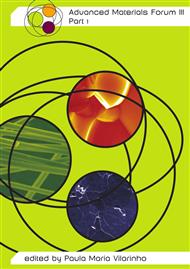p.63
p.68
p.73
p.78
p.83
p.88
p.93
p.98
p.103
Study of Electrochromic Devices Incorporating a Polymer Gel Electrolyte Component
Abstract:
Electrochromic materials have attracted considerable attention during the last two decades as a consequence of their potential application in several different types of optical devices. Examples of these devices include intelligent windows and time labels. In this paper the authors describe results obtained with thin tungsten oxide films produced at room temperature by rf magnetron sputtering under an argon and oxygen atmosphere on transparent conductive oxide coated glass substrates. To protect the surface of the electrochromic film, prevent water absorption and obtain a good memory effect under open circuit voltages, a layer of Ta2O5 was deposited over the WO3 films. In this study, the effect of different electrolyte compositions on the open circuit memory of optical devices has been characterized. The best results were obtained for electrochromic devices with polymer gel p(TMC)3LiClO4 and p(TMC)8LiClO4 electrolytes. These prototype devices present an overall transmittance of ~75% in their bleached state and after coloration 40.5 and 52.5% respectively. These devices also show memory effect and an optical density considered satisfactory for some electrochromic applications.
Info:
Periodical:
Pages:
83-87
Citation:
Online since:
May 2006
Price:
Сopyright:
© 2006 Trans Tech Publications Ltd. All Rights Reserved
Share:
Citation:


